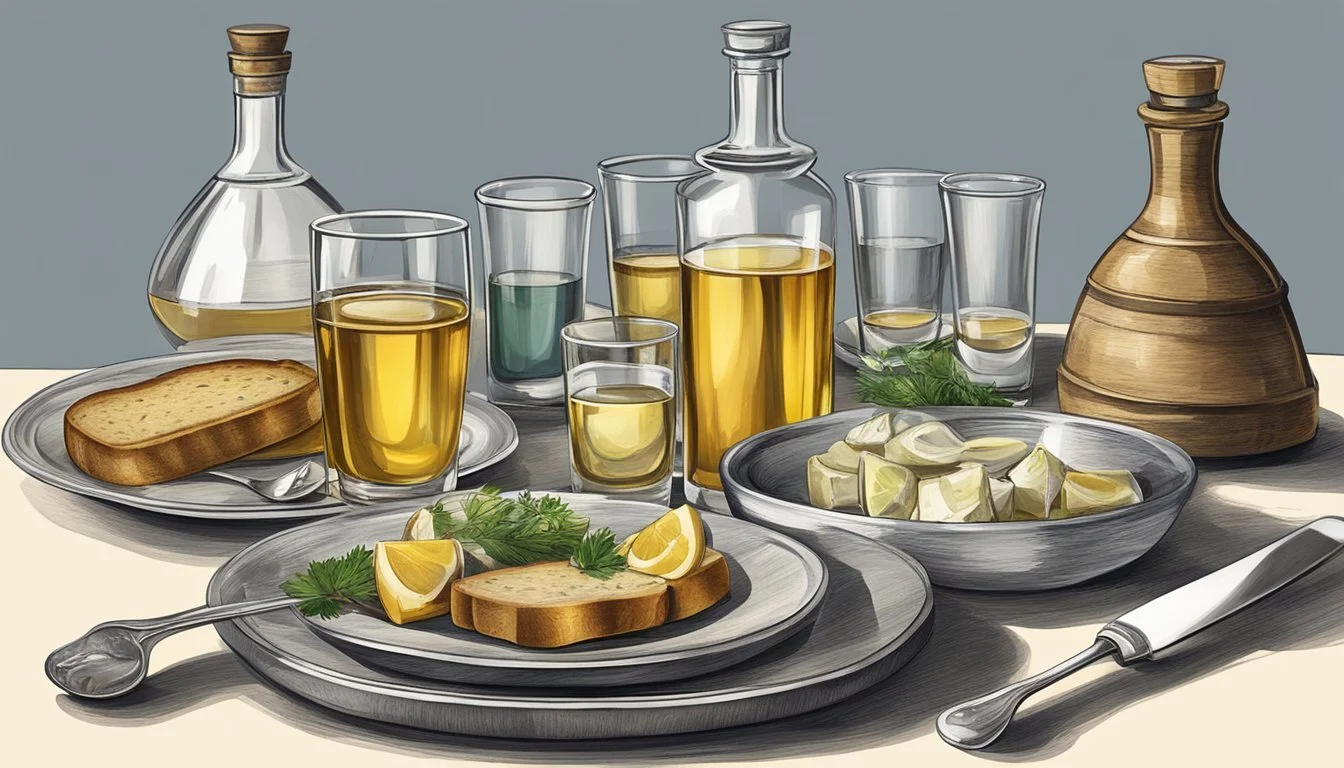How Many Servings of Aquavit Is Too Much
Understanding Safe Consumption Limits
When it comes to enjoying Aquavit, moderation is key. This beloved Nordic spirit, traditionally flavored with caraway and dill, boasts a relatively high alcohol content, typically around 37.5% ABV. For women, the recommended serving size is 1.5 ounces per day, while men should not exceed 2.0 ounces.
Aquavit’s robust and aromatic profile makes it a favorite in Scandinavian cultures, where it is often consumed during festive occasions. When enjoyed responsibly, it can be a delightful addition to social gatherings or a cozy evening at home. It's important for individuals to consider their own health and tolerance levels, as the effects of alcohol can vary based on several factors.
Incorporating Aquavit into your routine should always be done with awareness. Understanding your limits and respecting recommended guidelines will ensure that this traditional spirit can be enjoyed safely and responsibly.
Understanding Aquavit
Aquavit, also known as Akvavit, is a traditional Scandinavian distilled spirit flavored primarily by caraway and dill. Its rich history and cultural significance in countries like Norway, Sweden, and Denmark make it a unique beverage, often enjoyed during festive occasions.
Historical Background
Aquavit has deep roots in Scandinavia, originating in the 15th century. It's a vital part of cultural ceremonies, especially in Norway and Sweden, where it is consumed during midsummer celebrations and Christmas. The name "aquavit" derives from the Latin phrase aqua vitae, meaning "water of life," highlighting its valued status throughout history. Distilleries in these regions have perfected their recipes over centuries, producing distinctive varieties that reflect local traditions.
Production Process
Producing aquavit involves several intricate steps. The process starts with distilling grains or potatoes to create a neutral spirit. Botanical ingredients, mainly caraway and dill, are then added to the distilled spirit. These botanicals infuse the liquor with its characteristic flavors. The mixture is often aged in oak barrels, which can add complexity and depth to its taste. Distilleries may also use additional botanicals like fennel, anise, or citrus peels to enhance the flavor profile.
Common Ingredients
Caraway and dill are the signature flavors of aquavit, offering a distinctive taste. Other common ingredients include anise, fennel, cumin, and grains of paradise. The specific blend of herbs and spices varies by brand and region, creating a unique profile for each type of aquavit. In addition to these spices, some varieties might include botanicals like citrus peels or cinnamon. These additions contribute to the spirit's aromatic and flavorful complexity, making each bottle a unique experience.
Cultural Significance
Aquavit holds an important place in Scandinavian culture, symbolizing tradition and festivity. Its role extends beyond mere consumption, intertwining with celebrations and family gatherings, both in the Nordic regions and increasingly around the world.
Aquavit in Scandinavian Traditions
In Scandinavian traditions, aquavit is a central element during festive occasions such as Christmas and Easter. It marks moments of celebration, often enjoyed during meals or special gatherings.
The spirit is typically sipped slowly to savor its unique flavors, which are often derived from botanicals like caraway and dill. Danish "snaps", a variant of aquavit, is particularly popular and served cold. Historically, aquavit has been a symbol of hospitality, bringing families and communities together around the table.
Aquavit's Global Reach
Aquavit is gaining recognition beyond the Nordic countries. Its distinct flavor profile and rich cultural heritage appeal to a global audience. In addition to traditional adoptions, aquavit is now featured in cocktail menus around the world, introducing new flavors to diverse palates.
Efforts by various brands to market and distribute aquavit internationally have contributed to its global reach. Educational campaigns about aquavit's cultural background and tasting profiles help bridge the gap between Scandinavian traditions and new consumers worldwide.
Consumption Guidelines
Moderation is crucial when consuming Aquavit, a traditional Scandinavian spirit. It is important to consider safe drinking practices and understand how servings can affect your health.
Safe Drinking Practices
Health authorities recommend moderation for alcohol consumption.
For Aquavit, a spirit typically around 40% ABV (80 Proof), this translates to approximately 1.5 ounces per serving.
The CDC advises that women should limit themselves to no more than 7 drinks per week and men to no more than 14 drinks per week. This helps minimize risks linked to alcohol misuse.
Pairing Aquavit with food can aid digestion and reduce alcohol's impact on the body. Including nutritious snacks can further mitigate potential adverse effects.
Staying hydrated and pacing consumption also supports safer drinking habits.
Aquavit Varieties
Aquavit, a Scandinavian spirit, boasts a range of varieties influenced by region and diverse flavor profiles. Its distinct botanical mix results in unique tastes across different countries and brands.
Regional Differences
Scandinavia is the heartland of Aquavit, with each country offering its own take on this spirit. Norwegian Aquavit is often aged in oak casks, giving it a rich, golden hue and a smoother taste. Swedish Aquavit tends to be lighter and more aromatic, emphasizing fresh herbal flavors. Danish Aquavit is typically clear and characterized by a strong caraway flavor, adhering to traditional recipes.
In Norway, brands like Linje Aquavit age their spirits as they travel across the equator, enhancing their complexity. Sweden's O.P. Anderson Aquavit, known for its balanced, herbaceous profile, contrasts with Denmark's Aalborg Taffel Akvavit, which is crisp and boldly caraway-forward.
Flavor Profiles
Aquavit's flavor profiles are diverse, yet certain botanicals are consistently used. Caraway and dill are the primary flavors in most varieties. Variations include hints of anise, fennel, and citrus peels like lemon or orange. These botanicals create a spectrum of tastes, from spicy and robust to light and zesty.
For example, a dill-based aquavit might pair well with seafood, enhancing the dish's freshness. Anise and fennel bring a more earthy, licorice-like taste, while citrus peels offer a bright, refreshing note. This versatility allows Aquavit to be enjoyed in various settings, whether sipped neat or mixed in cocktails.
Pairing Aquavit
Aquavit pairs wonderfully with various foods and can elevate cocktail experiences. Its complex flavors derived from caraway, dill, and other botanicals enhance the dining and drinking ritual.
Traditional Food Pairings
In Scandinavia, aquavit is often enjoyed with food, making it an integral part of the meal. Seafood is a classic pairing; think pickled herring, which complements the herbal notes of aquavit.
Meat dishes like cured meats and sausages also pair well. The caraway and dill in aquavit balance the richness of these foods.
Cheese platters, especially those featuring strong, aged varieties, can benefit from aquavit's unique taste profile.
Another traditional pairing involves rye bread. The robust, earthy flavors of rye bread harmonize with the distinct spices in aquavit.
Aquavit in Cocktails
Aquavit can invigorate cocktails, offering a fresh twist on traditional recipes. Some popular cocktails incorporate aquavit to stand out from more common liquors like gin or vodka.
One example is the Scandinavian Picnic, a cocktail that pairs well with a smörgåsbord of dishes, enhancing the meal with its botanically rich profile.
The versatility of aquavit allows it to blend well with a variety of ingredients, from citrus peels to fennel, adding depth to many cocktails.
Herbal notes in aquavit, such as anise and caraway, make it ideal for cocktails that feature similar ingredients. This makes it a favored choice among bartenders looking to create unique and memorable drinks.
Responsible Enjoyment
When indulging in aquavit, it is essential to balance enjoyment with health and social responsibilities. Being mindful of one's health and the effects of alcohol on social interactions ensures a pleasurable experience without negative repercussions.
Health Considerations
Aquavit, or akvavit, typically contains about 37.5% to 40% alcohol by volume. Due to its high alcoholic content, moderation is crucial.
For women, a recommended serving size is 1.5 ounces per day, and for men, 2.0 ounces. Exceeding these limits can result in health issues such as liver damage, high blood pressure, and increased risk of chronic diseases. Additionally, aquavit's high calorie content may contribute to weight gain if consumed in excess.
Beyond calories, aquavit is traditionally flavored with botanicals like caraway or dill, which have been believed to aid in digestion. However, these potential medicinal benefits are outweighed by the adverse effects of excessive consumption. Moderation remains key to enjoying aquavit without compromising health.
Drinking and Social Responsibility
Social settings frequently feature aquavit, making it vital to drink responsibly. Ensuring one's behavior remains respectful and considerate is part of responsible enjoyment. Avoiding binge drinking reduces the risk of harmful behavior, impaired judgment, and accidents.
Establishing a limit before starting is a practical approach. Encouraging friends to do the same creates a more enjoyable and safe environment. If driving is involved, ensuring a designated driver or arranging alternative transportation is crucial.
In social contexts, the goal is to savor and appreciate the drink rather than overindulge. By exercising restraint, everyone can maintain a positive atmosphere, promoting safe and responsible drinking habits.
The Art of Serving Aquavit
Serving Aquavit properly can greatly enhance the drinking experience. Two key factors to consider are the choice of glassware and presentation, as well as the optimal temperature and storage of the spirit.
Glassware and Presentation
Aquavit is traditionally served in small, stemmed glasses known as aquavit glasses. These glasses are designed to enhance the aromatic profile of the spirit. Bartenders often recommend using these specific glasses to ensure the drink's flavors are fully appreciated.
Presentation plays a crucial role. A neat pour shows respect for the spirit’s quality. Some choose to garnish with herbal or floral elements like dill or citrus peels, complementing the aquavit's botanicals without overwhelming them.
Avoid heavy mixers such as cream or rich syrups which can mask the nuances of aquavit. Instead, light garnishes that complement its profile are preferred. This attention to the details of glassware and presentation helps in truly savoring the unique flavors of aquavit.
Temperature and Storage
Aquavit should be served chilled to accentuate its flavors. Storing it in the freezer ensures it is always at an optimal serving temperature. This also gives the spirit a pleasantly smooth texture when sipped.
Once opened, it is best to keep aquavit in a cool, dark place to maintain its quality. Proper storage helps preserve the delicate balance of the various botanicals. For long-term storage, sealed bottles can also be kept in the refrigerator.
Keeping aquavit chilled and properly stored ensures that each pour delivers the intended aromatic and flavor profile. This attention to temperature and storage conditions highlights the dedication to serving aquavit correctly.
Aquavit Around the World
Aquavit, a traditional Nordic spirit, has carved out a niche for itself globally, influencing various markets and sparking innovation. Its presence in the United States highlights a burgeoning interest, while new creative approaches come from different parts of the world.
Influence on Global Spirits
Aquavit’s distinct caraway and dill flavors set it apart from other spirits, influencing bartenders worldwide. American Bartenders praise its herbal profile, using it to create unique cocktails.
In Australia, aquavit is gaining traction in the craft spirits scene. The travel culture, coupled with social media platforms like Instagram, further boosts its global reach.
Countries where aquavit wasn't traditionally known are now seeing an increase in its popularity, thanks to these global influences.
Aquavit in the United States
In the United States, aquavit’s popularity is climbing rapidly. The number of American aquavit distilleries rose from fewer than 10 in 2012 to over 50 by 2017. American Bartenders use it in innovative ways, integrating it into classic cocktails and creating new recipes.
The diligent local distillation processes ensure high quality, and the spirit's versatile flavor profile appeals to a wide range of tastes. Aquavit’s potential to shine in boutique bars and high-end restaurants underscores its increasing popularity.
Innovations in Aquavit
Innovations in aquavit production and presentation abound, driven by creative distillers. New flavors and infusions are being explored, integrating ingredients like anise, fennel, and citrus peels.
Some innovative brands even focus on unique production techniques, such as aging aquavit during long sea journeys. American distilleries lead in experimenting with new recipes, thereby expanding aquavit’s traditional boundaries.
These innovations not only showcase aquavit’s versatility but also contribute to its growing appeal in the global market.
Supporting the Industry
Promoting the Aquavit industry involves bolstering local distilleries and increasing market awareness. Both facets are crucial for the sustained growth and recognition of this traditional spirit.
Supporting Local Distilleries
Local distilleries are at the heart of the Aquavit industry. By prioritizing these smaller-scale producers, consumers can enjoy unique, high-quality flavors that larger brands might overlook. Distilleries, often helmed by passionate founders, rely on community support to thrive. Purchasing from local distillers not only helps maintain traditional methods but also fosters innovation within the industry.
Visiting distilleries, engaging in tours, and participating in tasting events also provide direct support. Such activities raise awareness and appreciation for Aquavit, driving demand. Local bars and restaurants featuring local Aquavit brands further extend visibility, encouraging others to explore these artisanal options.
Aquavit in the Market
Aquavit's market presence has grown, yet awareness remains crucial for its expansion. Retailers can play a significant role by stocking a diverse range of Aquavit bottles. Highlighting both well-known and emerging distilleries ensures consumers have access to various expressions of the spirit.
Marketing strategies that emphasize Aquavit's rich history and unique production methods can attract enthusiasts. Educational campaigns, tastings, and promotional events also help in familiarizing a broader audience with Aquavit. Collaborations with bartenders and mixologists to create signature Aquavit cocktails can also make it a staple in bars and restaurants.
Listing Aquavit prominently on menus and shelf displays can further drive interest. Ensuring that retail staff are knowledgeable about Aquavit can enhance customer experiences and foster a culture of exploration and enjoyment.











